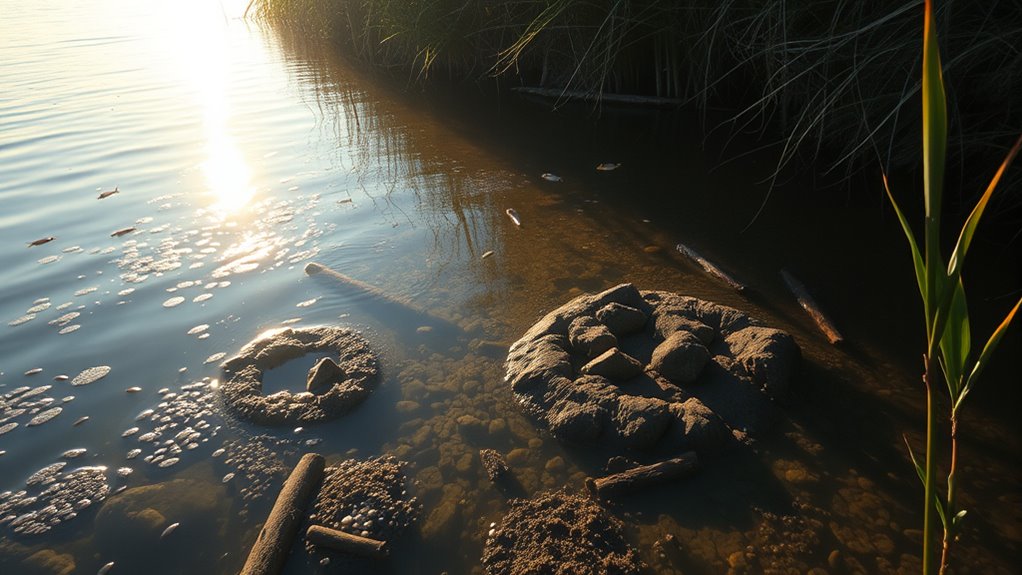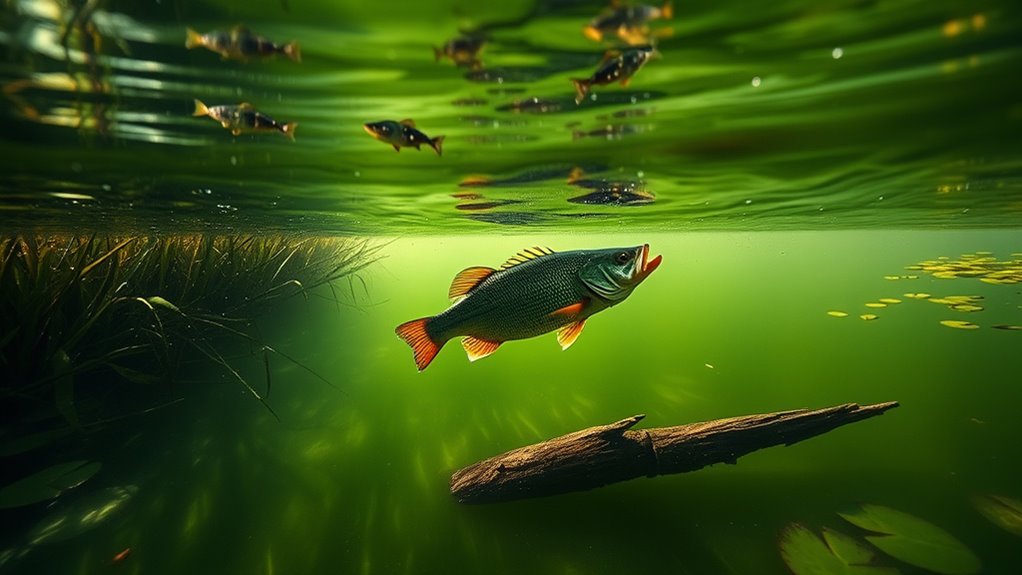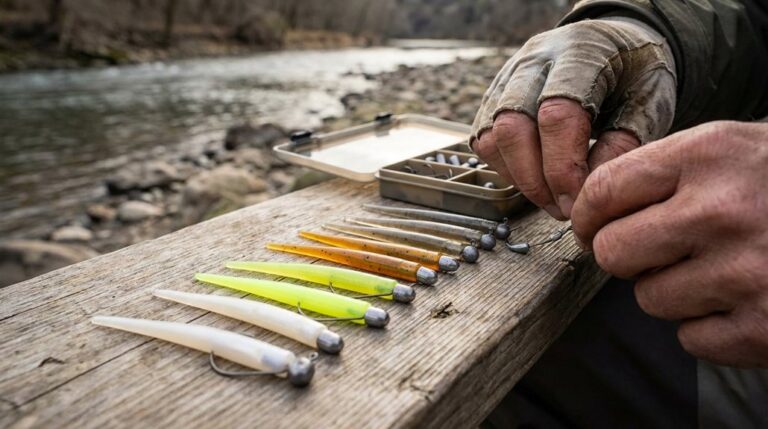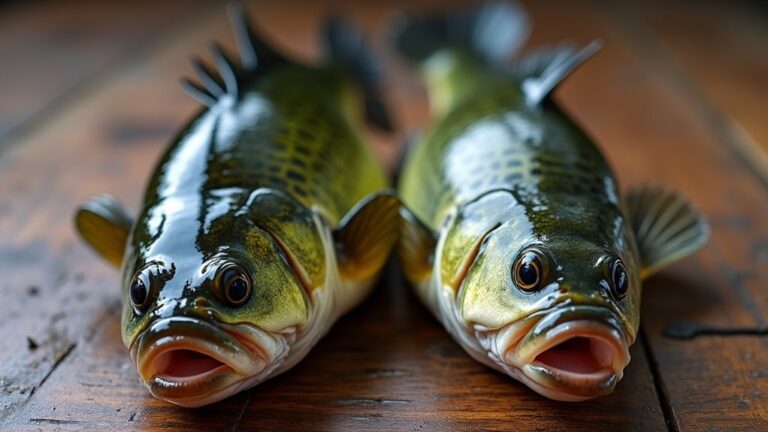Largemouth bass are ambush predators you’ll find in vegetation, around structure, and deeper edges where baitfish congregate. Juveniles hide in weeds; adults shift seasonally—shallow in spring to spawn, split between deep humps and shallow cover in summer, then follow baitfish fronts into fall before moving to wintering areas. They eat insects, fish, even small birds, striking quickly from cover. Temperatures and prey drive where and how they feed, and more specifics follow below.
Important Takeaways
- Largemouth bass use vegetation and structure for ambush hunting, with juveniles favoring dense cover and adults using deeper structure.
- Seasonal shifts: spring brings shallow spawning areas, early summer splits deep and shallow, summer follows baitfish fronts, fall migrates toward winter grounds.
- Peak feeding occurs at 65–80°F, with low-light dawn/dusk bites and active ambush strikes from cover.
- Males build and guard nests at water temps above ~60°F; females lay eggs across multiple nests, producing thousands of eggs.
- Effective tactics vary by season: spring jerk/topwater pauses, summer cranks/drop-shots/Ned rigs, fall jigs/spinnerbaits, winter small spoons/jigs deep.
Basic Description and Biology of Largemouth Bass
Curious how largemouth bass look and behave? You’ll recognize Largemouth bass (Micropterus salmoides) by their big mouths and stocky bodies; they’re widespread and often introduced beyond native ranges. You depend on knowing their habitat and depth distribution: juveniles stick to vegetation cover while adults use deeper water to ambush prey. As an ambush predator, a bass’s feeding is opportunistic—everything from insects to small fish, even snakes or birds—with prey size sometimes reaching half the bass’s length. You should note sexual dimorphism: females get noticeably larger. Spawning starts when water temperature exceeds about 60°F (16°C), with males building and guarding nests. Typical wild lifespans run 10–16 years, shaping population structure you’ll encounter. Anglers often target bass during dawn and dusk when their feeding activity increases.
Seasonal Movements and Habitat Shifts
After spawning wraps up and males stop guarding nests, largemouth bass shift their movements with the seasons, moving from the protected shallows of spring into patterns driven by water temperature, prey distribution, and cover. You’ll see pre-spawn movement toward shallow water as temps climb near 60°F, then post-spawn feeding scatters fish into sunlit zones. Watch how habitat shifts through the year:
- Spring: you find bass in shallow water and vegetation, staging for spawn and feeding on concentrated prey.
- Early summer: population splits—deep fish on humps and channels, shallow fish under docks and in weeds.
- Summer patterns: bass follow baitfish and fronts, moving between deep and shallow cover.
- Fall transition: they ride a “bus route” toward winter grounds as prey moves shallower.
Conservation efforts for related species emphasize maintaining native vegetation and flow conditions to support these seasonal habitat needs, especially in central Texas waters where habitat management has helped sustain populations and reduce genetic threats to native bass habitat management.
Spawning Behavior and Nesting Sites

Where do largemouth bass choose to spawn, and why those spots matter: males pick shallow, protected areas—coves, bays, creek back ends—and often site nests against pilings, docks, rocks, laydowns, or breakwalls so they can better defend eggs and fry. You’ll see males arrive first, clearing sediment to create clean nest bowls and establishing structure coverage that aids nest guarding. Females visit later, laying eggs across multiple nests to spread genetic risk while males release sperm for fertilization. Spawning follows water temperature 55-65 and often aligns with lunar cycles, producing waves of nest construction. Incubation and early fry care remain male responsibilities; despite intense guarding, egg survival stays very low, so females produce thousands of eggs.
Feeding Habits and Predatory Strategies
Why do largemouth bass often seem to appear out of nowhere? You’re watching baitfish when an ambush predator explodes from cover and structure, using a large jointed mouth to suck in prey items. Their predatory strategy is opportunistic: they follow schools, lurk in vegetation, and exploit low light feeding at dawn and dusk. Water temperature drives activity—65–80°F sees peak feeding, and spring spawning behavior briefly alters locations.
- Use cover and structure to hide and strike quickly.
- Track baitfish movements and fronts to find concentrated prey.
- Accept diverse prey items: crayfish, frogs, rodents, birds, smaller bass.
- Males guard fry post-spawn while both sexes resume aggressive feeding. Ice anglers should always verify ice thickness and safety before venturing onto frozen water.
Best Fishing Tactics by Season

How do you match tactics to the calendar? You read Largemouth bass habitat cues and apply seasonal fishing tactics. In spring, when water temperature climbs toward the 60–65°F spawning range, head for shallow spawning areas and use jerkbaits and topwater with long pauses to trigger lethargic fish.
In summer, prioritize cover and structure and mix crankbaits, drop shots, Ned rigs and topwater; low-light fishing opportunities can ignite both shallow and deep water fishing.
In fall, chase active baitfish: work jerkbaits, spinnerbaits and jigs as forage and baitfish move into pockets and bass gorge.
In winter, downsize to small spoons and jigs, fish deeper, warmer pockets, and be patient—target structure where localized bites still occur. Always prioritize safety by carrying essential ice fishing gear and checking ice thickness before venturing onto frozen water.
Final Thoughts
You’ll better understand largemouth bass if you remember they’re adaptable ambush predators that shift habitats with the seasons to feed, spawn, and shelter. In spring they move shallow to nest and are aggressive; in summer they seek cover and cooler water; in fall they feed heavily to bulk up; in winter they slow down and go deeper. Use seasonally appropriate tactics—presentation, depth, and cover—to match their patterns and improve your success on the water.




